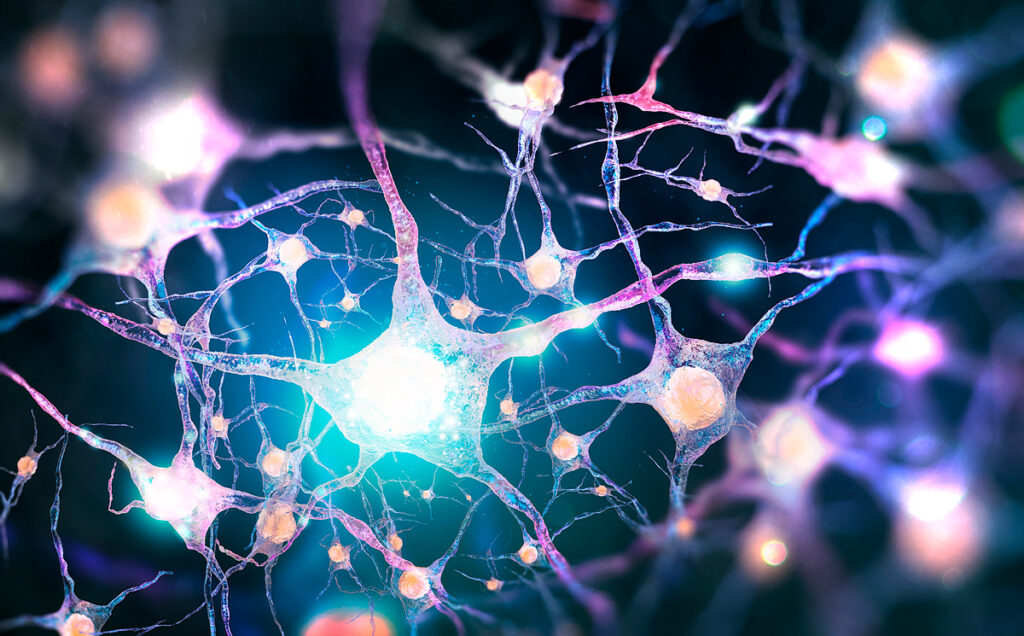The tick-borne encephalitis virus (TBE) is transmitted by biting an infected ixodid tick and eating unpasteurized dairy products from infected animals. The incubation period of TBE with a tick bite lasts from 7 to 21 days, and when the virus enters the body with food-from 4 to 7 days. After the incubation period, fever, headache and muscle pain, nausea, or vomiting occur. These symptoms persist for about five days, after which they disappear. However, after a week of the asymptomatic course, 40-55% of patients develop neurological symptoms: severe headache, fever, impaired consciousness and sensitivity, paralysis. This is how inflammation of the membranes and substances of the brain and spinal cord manifests itself – meningitis, encephalitis, meningoencephalitis, and myelitis. Long-term symptoms may persist for more than a year. In some regions of the Russian Federation, patients with tick-borne encephalitis die in 9-17% of cases.
Vaccination and increased prevention measures against tick bites – closed and tucked-in clothing, sprays, and regular checkups-have reduced the incidence of tick-borne encephalitis. According to the Federal State Statistics Service of the Russian Federation, in 2018, compared with 2005, the incidence decreased by 2.7 times. However, the problem of TBE is still relevant – in 2018, 1.7 thousand cases were registered in Russia.
So far, there is no specific treatment for TBE. Tick-borne encephalitis is treated with anti-tick immunoglobulin (IgG) in combination with broad-spectrum immunomodulators. IgG contains antibodies to the tick-borne encephalitis virus. IgG is produced from the blood of healthy donors. All donors are tested for HIV and hepatitis B and C, but not for other blood-borne infections, such as herpesvirus. These viral diseases can be asymptomatic but infect blood cells and are transmitted through drugs.
A study conducted in the clinic of neuro infections showed an insufficient protective effect of IgG. A possible reason is that antibodies alone are not enough to protect against tick-borne encephalitis. The antibodies neutralize the TBE virus while it circulates in the blood. However, they do not penetrate the infected cells, so that the tick-borne encephalitis virus can spread along the nerves. The TBE virus is only present in the blood for a short time. Therefore, cellular immune response is needed to eliminate the virus quickly.
Scientists of the Children’s Research and Clinical Center for Infectious Diseases (St. Petersburg, Russia) studied the protective properties of interferon alpha-2 as part of the complex therapy of acute and chronic tick-borne encephalitis. Recombinant interferon alpha-2 has immunomodulatory and antiviral properties to block the synthesis of viral particles and stimulate cellular and humoral immunity.
The study involved 130 children aged 8 to 17 years with focal forms of tick-borne encephalitis: in the acute period – 104 children, with chronic TBE – 26 children. The children were divided into groups and given different treatments:
- In the acute period:
Group 1 (84 children) received ribavirin at a dose of 10 mg/kg/day orally together with recombinant interferon-α2 (IFN-α2) at a dose of 1 million IU intramuscularly once a day for 1 month. After 1 month of treatment, patients received an anaferon of 1 tablet 3 times a day for 6 months. Anaferon is a drug of release-active antibodies to IFN-γ.
Group 2 (20 children) received IgG at a dose of 0.1 ml/kg/day intramuscularly for 7 days and ribonuclease 15-20 mg 3 times a day for 7-10 days.
- With a chronic course:
Group 3 (15 children) received ribavirin at a dose of 10 mg/kg/day orally for 4-6 months, depending on the dynamics of clinical and laboratory parameters. Simultaneously with ribavirin, patients received recombinant IFN-a2 1 million IU once a day intramuscularly for 1 month, and in the following 3-5 months-3 times a week intramuscularly or in the form of rectal candles. After the main course, the children took the drug release-active antibodies to IFN-γ 1 tablet 3 times a day for 6 months.
Group 4 (11 children) received IgG at a dose of 0.1 ml/kg/day intramuscularly once a day for 7 days in combination with ribonuclease 15-20 mg 3 times a day for 7-10 days, and the therapy was repeated every 3-4 months for 1 year.
In addition, all patients received neurometabolic, decongestant, dehydration, and antiepileptic drugs. The effectiveness of the treatment was evaluated for 1 year.
Despite the use of IgG, 10 children out of 31 (32%) with focal forms of tick-borne encephalitis developed neuro infection. All patients had elevated levels of lymphocytes in the cerebrospinal fluid, and there was a violation of consciousness.
The effectiveness of therapy in acute tick-borne encephalitis. Comparison of groups 1 and 2
In children in the group of ribavirin and interferon-alpha-2 (group 1):
- The fever disappeared faster.
- The period of increase in neurological symptoms was reduced by more than 2 times.
- Brain edema regressed faster, and consciousness was restored.
- The time spent in the intensive care unit was reduced by an average of 5 days, and in the hospital – by 16 days.
- Recovery without neurological deficits was 83.3%. In patients with residual neurological deficits, the severity of paresis, the frequency of epileptic seizures, and other manifestations showed positive dynamics compared to the acute period, and there were no laboratory signs of virus replication.
In children in the IgG and ribonuclease group (group 2):
- IgM antibodies to the tick-borne encephalitis virus were detected longer (IgM means the acute phase of infection). In 75% of cases, IgM in the blood serum persisted after 3 months and 12 months in 45%. For comparison, in 94% of children from group 1, IgM was not detected after 3 months.
- Viral antigens (AG) and viral RNA were detected longer in the cerebrospinal fluid. Viral AG or RNA were detected in 1/2 cases on the 15-19 days, and in 6 (30%) children, they were seen both 3 and 6 months after the start of treatment. For comparison, in 97.8% of children from group 1, the tick-borne encephalitis virus was not detected on the 15th-19th day of treatment.
- Only in 3 cases, the disease ended in recovery. In 30% of patients, the progression of symptoms was observed 3-4 months after the acute period. The absence of clinical progression and negative results of virological data allowed us to talk about complications and not about the chronic course of the infection.
In both groups 1 and 2, the foci of the hypertensive MRI signal regressed after a year. However, in children of group 1, the positive dynamics proceeded faster: after 3 months, foci were detected only in 7.1% of cases, while in group 2 – in 40%.
The effectiveness of therapy in chronic tick-borne encephalitis. Comparison of groups 3 and 4
In 21 (80.7%) cases, chronic tick-borne encephalitis was associated with ineffective therapy of the acute period. In these patients, the progression of symptoms occurred after a period of improvement lasting 1-3 months in 85.7% of cases (18 patients). In other cases, there was no improvement, and the symptoms gradually increased after the acute period.
In children in the group of ribavirin and interferon-alpha-2 (group 3):
- After 6 months of treatment, AG or RNA of the virus was detected in the cerebrospinal fluid in 20% of cases, and after a year – in none of the examined patients.
- After 1 year of therapy, 86.7% of cases showed positive dynamics with most symptoms regression.
- After 1 year from the start of treatment, the dynamics of MRI showed no increase in atrophic changes in the brain in most patients.
In children in the IgG and ribonuclease group (group 4):
- AG or TBE virus RNA was detected in the cerebrospinal fluid in 100% of cases, and IgM in the blood remained in 90.9% of patients during the entire treatment period.
- In 72.7% of cases, there was no positive trend. A stable picture of symptoms with no progression was observed only in 3 (18.2%) patients.
- MRI of the brain and spinal cord showed that in the absence of new foci of inflammation, atrophy and replacement hydrocephalus increased.
Conclusion
Treatment of acute tick-borne encephalitis with anti-tick immunoglobulin combined with ribonuclease is ineffective since patients experience brain edema and impaired consciousness longer, and the virus is detected longer in the cerebrospinal fluid. In chronic tick-borne encephalitis, the symptoms progress during therapy with IgG and ribonuclease, and negative dynamics of virological data and MRI results are observed.
Early use of ribavirin and recombinant interferon-a2b, as well as release-active antibodies to IFN-γ in acute tick-borne encephalitis, reduces the duration of symptoms and stops the replication of the virus in the cerebrospinal fluid by 15-19 days in 97.8% of children, and in 83.3% of cases allows for complete recovery.
This study serves as a justification for the introduction of antiviral treatment of tick-borne encephalitis and the rejection of anti-tick immunoglobulin.
Source
The efficacy of antiviral therapy and serotherapy of tick-borne encephalitis in children



